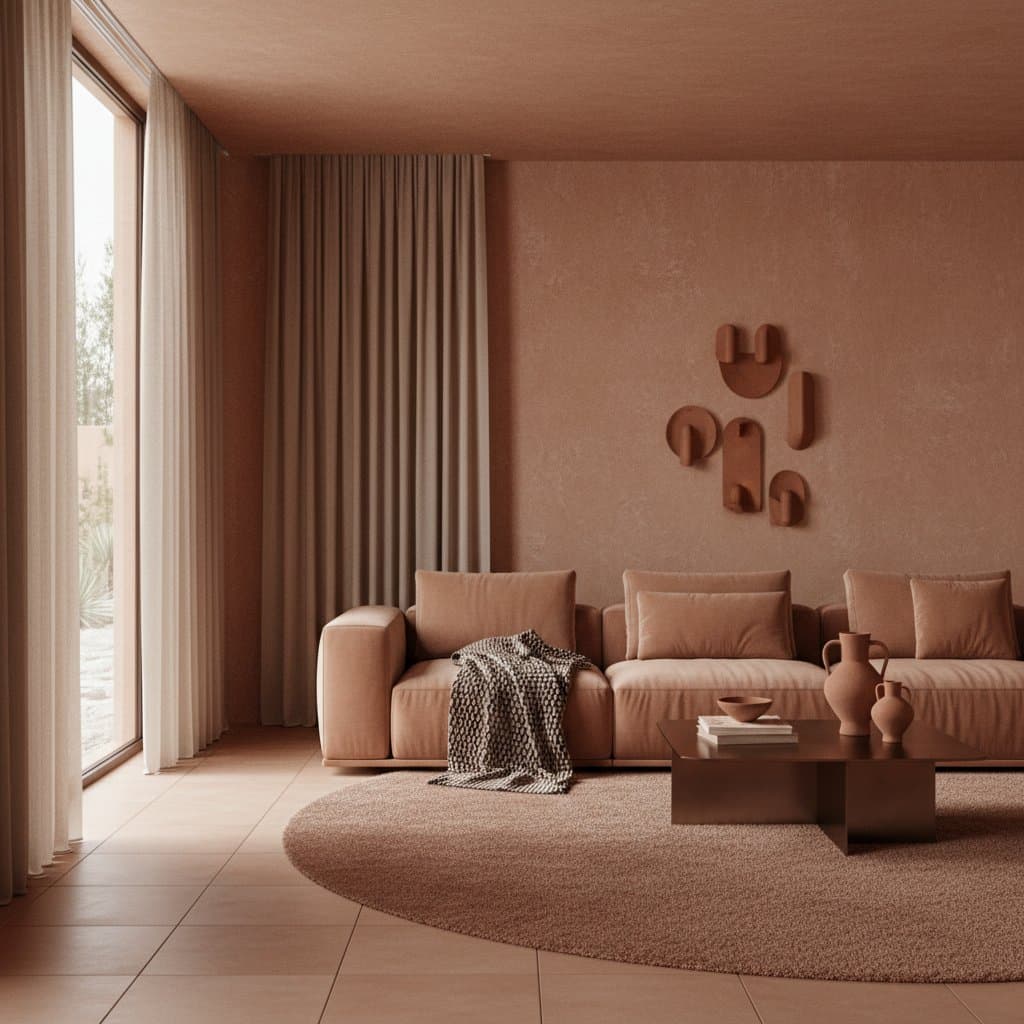Chromatic Minimalism: The Defining Trend for 2025
Many individuals experience a conflict between the desire for a serene, minimalist interior and the appeal of incorporating color. Chromatic minimalism addresses this tension by combining the precise lines of minimalism with immersive, tonal color applications that evoke both tranquility and boldness. This movement transforms spaces that might otherwise appear stark into environments rich in depth and character.
Minimalism attracts people with its emphasis on simplicity, yet some find it lacks vitality. Chromatic minimalism counters this by introducing warmth and personality through strategic color use, all while maintaining a clutter-free aesthetic. Those seeking a contemporary, rooted, and communicative home without overwhelming patterns or accessories will find this style particularly suitable.
Defining Chromatic Minimalism
Chromatic minimalism centers on employing a single color family across an entire space, incorporating subtle variations in shades and finishes. Envision a living room in soft sage green, where walls, upholstery, and window treatments align within the same spectrum, or a bedroom in deep navy that integrates matte walls, glossy accents, and textured linens in matching tones. This method delivers the composure of minimalism alongside the expressive power of color.
In contrast to conventional minimalism, which typically features whites, grays, and other neutrals, chromatic minimalism positions color as the focal element. The outcome produces interiors that feel more approachable and lively, yet remain structured and orderly.
Key Reasons for Its Popularity
- Promotes tranquility via uniformity. A unified color scheme allows the eyes to rest and the mind to unwind.
- Conveys deliberate design. Each element appears thoughtfully selected rather than haphazardly placed.
- Adapts well to compact areas. Harmonious tones expand the perceived size and enhance overall cohesion.
- Encourages innovation without excess. Experimentation with texture, luster, and subtle contrasts maintains unity.
Incorporating Chromatic Minimalism into Your Home
Implementation does not require overhauling every room. Begin with modest changes to gain assurance. The emphasis lies on achieving balance rather than flawless execution.
1. Select a Foundational Hue
Choose a color that resonates personally. Subdued options such as olive, rust, or muted blue prove more versatile for daily living than vivid primaries. For those inclined toward neutrals, consider warm beige or taupe, then add dimension through varied textures rather than stark contrasts.
Reflect on the desired ambiance for the space.
- Gentle and restorative: Opt for cooler shades like pale blue or soft gray.
- Cozy and welcoming: Select earthy hues such as terracotta or caramel.
- Assertive and assured: Choose saturated tones like emerald or charcoal.
2. Apply Color Drenching
Color drenching involves applying the selected hue across several surfaces. Walls, trim, ceilings, and furnishings can share the same shade or close variants, fostering an enveloping, contemporary atmosphere.
If full commitment seems daunting, initiate with two primary elements, such as walls and curtains. Observe how the color interacts with light before extending the application.
3. Integrate Textures and Finishes
With color variation minimized, texture assumes a vital role. Pair matte painted surfaces with velvet pillows, linen drapes, or brushed metal hardware to create dynamic interplay.
Consider these combinations:
- Glossy ceramics alongside plush textiles
- Sleek wall finishes with woven floor coverings
- Matte storage units paired with gleaming accents
These choices capture light variably, preventing a monotonous appearance.
4. Curate Restrained Yet Impactful Decor
Minimalism flourishes through selectivity. Feature only cherished items. One prominent artwork or a sculptural vessel often surpasses the effect of numerous smaller objects.
Select pieces that align with the palette or remain sufficiently neutral to avoid disruption.
5. Optimize Lighting
Warm illumination amplifies the richness of deeper tones, whereas cooler light imparts crispness. Experiment with bulb types prior to final decisions. Incorporate dimmers for mood versatility throughout the day.
Natural daylight alters perceptions, so evaluate paint swatches and fabric samples under varying conditions before purchasing.
Weighing Advantages and Drawbacks
Design decisions involve compromises. Chromatic minimalism offers distinct benefits alongside potential challenges.
Advantages:
- Establishes a distinctive visual signature for the residence
- Fosters an orderly and restful environment
- Accommodates high-end and economical materials alike
- Simplifies upkeep after initial setup
Drawbacks:
- Risks monotony without sufficient textural or formal diversity
- Demands precise hue coordination, potentially raising expenses for paints and fabrics
- Restricts adaptability for future styling if preferences shift
For renters or those anticipating relocation, employ reversible elements like linens, window treatments, and artwork instead of fixed alterations such as painting.
Essential Practical Aspects
Budget: Anticipate marginally higher costs for paints and finishes due to the need for custom blending or testing. Refreshing a modest room may range from several hundred to one thousand dollars, contingent on chosen materials.
Timeline: Coordinating and applying finishes extends beyond a basic update. Allocate at least a few days for preparation, application, and curing.
Labor: Tasks remain manageable, though precision is essential. Uniform edges, consistent coverage, and matched finishes determine success.
Expert Assistance: For color selection uncertainties, engage a consultant to refine tonal harmony. Many paint retailers provide this guidance for a reasonable charge.
Sustaining Chromatic Minimalism
Upon completion, the space radiates composure. The lack of visual clutter promotes relaxation, complemented by the engaging depth of a singular color. Preserve equilibrium by introducing new items only if they complement the scheme or serve a clear function.
Seasonal updates through interchangeable accents like pillows or blankets sustain freshness within the established tones. This strategy anchors the design while permitting gentle evolution.
Steps to Embrace This Style
Identify a room primed for transformation and gather tonal samples. Consult lighting conditions and personal preferences to finalize choices. Proceed incrementally to build a cohesive, calming interior that reflects individual taste.
